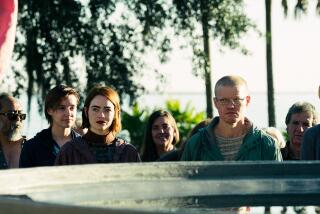Deft Handling of Tangled Relationships
- Share via
Ten years after John Malashock left the Twyla Tharp company to form his own modern dance ensemble in San Diego, he remains obsessed by obsession, still creating one distinctive dance drama after another about oppressive, destructive relationships. In a typically bracing, finely crafted but ridiculously under-attended anniversary program at Occidental College on Friday, his nine dancers performed recent pieces that seemed part of one, single, evolving life’s work.
The characters Malashock invents need closeness even more than they need to escape from it, so they continually ricochet between extremes, expressing their conflicts in a movement style that contrasts remarkably fluid upper limbs and torsos with driving, steely legwork, their bodies divided almost as drastically as their feelings. Other hallmarks of his include unusual, often cryptic music that adds an ironic perspective to the action and bold gymnastic lifts that dramatize the weight and strain of body against body.
Set to recordings by the Portuguese group Madredeus, “Midnight in Paradise” begins deceptively with a lyrical ensemble sequence--the dancers buoyantly skimming the stage and then stretching out on the floor in sunburst patterns. Before long, however, we see Ali Fischer and Tammy Dunsizer locked in a force field of unresolved need that ends in an archetypal Malashock clinch: the two women holding one another with one hand but pushing each other away with the other. We also see Fischer trapped in a circle of men--lifted like a dead stag after a hunt--but compulsively throwing herself back to them even after escape becomes possible.
If women’s hands pinioned over their heads becomes a familiar part of the landscape in Malashock’s “Paradise,” his grimly satiric “Love and Murder” gives both sexes equal opportunity as victims and victimizers. To simultaneously funny and nasty songs by Nick Cave & the Bad Seeds, various whimsical acts of violence occur, ending with someone hauled off to the morgue. Former Lewitzky and Loretta Livingston dancer Michael Mizerany falls first, in combat with James Healey, but immediately afterward these foes unite to dispatch the devoted (a.k.a. smothering) women in their lives.
That’s human destiny in the Malashock universe: This time you’re the stalker, next time the stalked--or maybe just part of the cleanup crew disposing of an unmanageable dead body. “People ain’t no good,” a song cheerfully reminds us, as soloists emerge from a jaunty line dance to perform character vignettes illustrating the text. Malashock here takes showpiece dancing over the edge into crazed gallows humor, creating a mock-celebratory panorama of the basest instincts and behavior.
His equally comic “Give Me a Bud and a Slice” reveals a darker view, showing an energetic young couple (Healey and Jodi Leigh Allen) gradually becoming indistinguishable from their slumping, slothful elders (Malashock and Dunsizer).
Five excerpts from the suite “Let’s Duet” confirmed Malashock’s originality and the excellence of his current company, with the playful relationships in the male duet “Carryin’ a Friend” and the female trio “In a Quiver” embodying a more benign perspective than his larger-scale works.
More to Read
The biggest entertainment stories
Get our big stories about Hollywood, film, television, music, arts, culture and more right in your inbox as soon as they publish.
You may occasionally receive promotional content from the Los Angeles Times.










